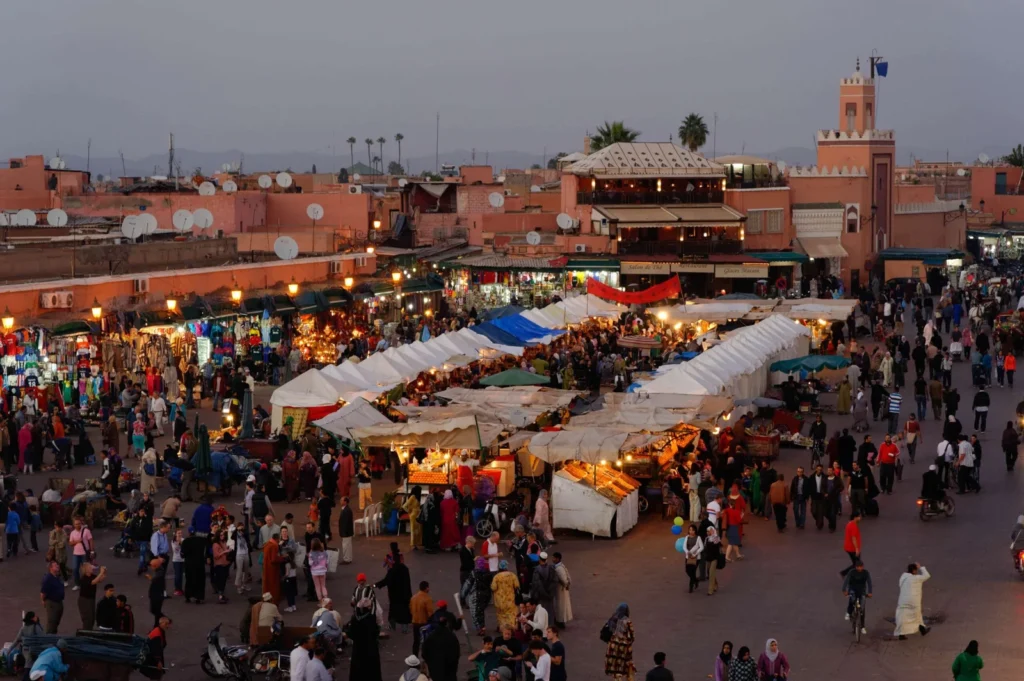
Morocco’s ancient cities of Marrakech and Fes are like two sides of a vibrant coin, each offering a distinct yet complementary glimpse into the country’s rich cultural tapestry. As I wandered through the labyrinthine medinas, sipped mint tea in hidden riads, and listened to the call to prayer echo through the streets, I felt the pulse of history and tradition. Cultural tourism in these UNESCO World Heritage cities isn’t just about sightseeing—it’s about immersing yourself in a living, breathing heritage that spans centuries. In this blog post, we’ll dive deep into what makes Marrakech and Fes irresistible for cultural travelers, blending storytelling, expert insights, and practical tips to inspire your own journey.
The Heartbeat of Morocco: Why Cultural Tourism Matters
Cultural tourism is more than checking landmarks off a list; it’s about connecting with a destination’s soul through its traditions, art, cuisine, and people. In Marrakech and Fes, this connection feels immediate. The medinas—walled historic districts—are living museums where artisans hammer copper, storytellers captivate crowds, and the scent of spices lingers in the air. According to UNESCO, both cities’ medinas are globally recognized for their cultural significance, preserving architecture and traditions dating back to the 9th century. My first evening in Fes, lost in the maze of Fes el-Bali, I stumbled upon a weaver crafting intricate textiles. His hands moved with a rhythm passed down through generations, a reminder that cultural tourism supports local economies and keeps traditions alive. This immersive experience is why travelers flock to Morocco, seeking authenticity in a world that often feels homogenized.
Cultural tourism also fosters mutual understanding. In Marrakech’s Jemaa el-Fnaa square, I watched snake charmers, henna artists, and musicians create a vibrant cultural mosaic. It’s chaotic yet harmonious, a microcosm of Morocco’s diversity. Living Tours emphasizes that cultural tourism promotes respect for local traditions, encouraging sustainable practices that preserve heritage. Whether you’re bargaining in a souk or joining a local family for a tagine, these interactions bridge cultures and create lasting memories.
Marrakech: The Red City’s Cultural Kaleidoscope
Marrakech, often called the “Red City” for its terracotta walls, is a sensory overload in the best way possible. The medina, a UNESCO World Heritage Site, pulses with life, from the bustling souks to the serene riads tucked behind unassuming doors. My first morning in Marrakech, I stepped into Jemaa el-Fnaa, where the square transformed from a quiet morning market into a nocturnal circus of storytellers, food stalls, and performers. It’s a place where Morocco’s Berber, Arab, and Andalusian influences collide, creating a cultural experience that’s both chaotic and captivating.
Must-Visit Cultural Sites in Marrakech
- Jemaa el-Fnaa Square: This iconic square is the heart of Marrakech’s cultural scene. By day, explore juice stalls and spice vendors; by night, join locals for street food and live performances. Tripadvisor ranks it among the top attractions for its vibrant atmosphere.
- Medersa Ben Youssef: This 14th-century Quranic school showcases intricate tilework and stucco. I spent an hour marveling at its courtyard, a testament to Morocco’s Islamic architecture. It’s a must for history buffs.
- Bahia Palace: A 19th-century masterpiece, this palace blends Moroccan and Islamic design with lush gardens. Its grandeur reflects Marrakech’s historical role as a cultural hub.
- Jardin Majorelle: Though often crowded, this garden, once owned by Yves Saint Laurent, offers a tranquil escape with its vibrant colors and Berber museum. Life With Bugo suggests booking early morning tickets to avoid crowds.
Cultural Experiences in Marrakech
Beyond landmarks, Marrakech offers hands-on cultural immersion. I joined a cooking class at a local riad, learning to make lamb tagine with preserved lemons. The chef shared stories of Berber culinary traditions, making the experience as educational as it was delicious. Viator offers similar classes, blending food with cultural storytelling. Visiting the souks, I haggled for a handwoven rug, guided by a shopkeeper’s tales of his village’s weaving techniques. These interactions highlight how cultural tourism supports artisans, as noted in a 2019 study on Moroccan medinas, which found tourism drives local economies but requires careful management to avoid commercialization Academia.edu.
Fes: The Spiritual and Cultural Capital
If Marrakech is Morocco’s vibrant heart, Fes is its soul. Known as the “Athens of Africa,” Fes el-Bali, another UNESCO World Heritage Site, is one of the world’s largest car-free urban zones. Wandering its 9,000 alleys, I felt transported to the Middle Ages. The medina’s authenticity, less touristy than Marrakech, captivated me. At Place Seffarine, I watched coppersmiths hammer intricate designs, their craft unchanged for centuries. Fes’s cultural depth lies in its preservation of traditions, from leather tanning to religious scholarship.
Key Cultural Attractions in Fes
- Al-Qarawiyyin University: Founded in 859 AD, this is the world’s oldest continuously operating university. Its library, with ancient manuscripts, is a scholar’s dream, though non-Muslims can only view the exterior.
- Chouara Tannery: The iconic leather tanneries, with their colorful dye vats, offer a glimpse into a centuries-old craft. I recommend a guided tour to understand the process fully.
- Bou Inania Madrasa: This 14th-century school is a masterpiece of Marinid architecture, with intricate zellige tiles and carved wood. It’s open to non-Muslims, unlike many mosques.
- Merenid Tombs: Perched on a hill, these ruins offer panoramic views and a haunting connection to Fes’s past. Visiting at sunset, I felt the city’s spiritual weight as the call to prayer echoed below Intrepid Travel.
Cultural Immersion in Fes
Fes’s cultural experiences are deeply rooted in its spiritual heritage. The city is a center for the Tijaniyya Sufi order, attracting religious pilgrims alongside secular tourists. I visited a zawiya (Sufi lodge) during a festival, witnessing devotees chanting in a candlelit courtyard—an experience that felt sacred yet welcoming. Journals Open Edition notes that religious tourism in Fes reinforces sacred topographies while supporting local economies. For a hands-on experience, I recommend joining a calligraphy workshop or visiting a local hammam, where traditional black soap rituals offer a cultural and sensory reset.
Comparing Marrakech and Fes: A Cultural Showdown
To help you decide which city suits your cultural travel style, here’s a comparison of Marrakech and Fes based on key factors.
| Aspect | Marrakech | Fes |
|---|---|---|
| Atmosphere | Vibrant, chaotic, and tourist-friendly. Jemaa el-Fnaa is a sensory spectacle. | Quieter, more authentic, with a spiritual and scholarly vibe. |
| Medina Experience | Bustling souks, easier to navigate with Google Maps. | Complex, less touristy alleys; requires a guide for first-timers. |
| Cultural Highlights | Bahia Palace, Jardin Majorelle, lively street performances. | Al-Qarawiyyin University, Chouara Tannery, historic madrasas. |
| Accessibility | Well-connected with international flights; tourist infrastructure. | Slightly less accessible but rewarding for those seeking authenticity. |
| Unique Draw | Colorful, modern energy with Berber and Arab influences. | Ancient, preserved traditions and spiritual depth. |
Both cities offer rich cultural experiences, but Marrakech is ideal for those craving vibrancy, while Fes suits travelers seeking history and introspection. I found Marrakech easier to navigate, but Fes’s authenticity left a deeper impression.
Practical Tips for Cultural Tourism in Marrakech and Fes
To make the most of your cultural journey, here are actionable tips based on my experiences and research:
- Hire a Local Guide: In Fes, the medina’s complexity demands a guide, especially on your first day. In Marrakech, a guide enhances souk visits by sharing historical context. GetYourGuide offers reputable tours.
- Dress Respectfully: While Marrakech is more relaxed, Fes’s conservative vibe calls for modest clothing, especially for women. I wore long skirts and scarves, blending in while staying comfortable.
- Learn Basic Phrases: Knowing a few words in Arabic or French (e.g., “shukran” for thank you) opens doors to warmer interactions. Locals appreciated my efforts, even if my pronunciation was shaky.
- Stay in a Riad: These traditional guesthouses offer an authentic experience. In Marrakech, Riad Sakkan was a cozy haven; in Fes, Riad Fes provided historic charm. Book via Booking.com for trusted options.
- Respect Local Customs: Avoid photographing people without permission, especially in Fes’s medina. During Ramadan, be mindful of eating in public during fasting hours.
- Bargain Wisely: Haggling is expected in souks, but keep it friendly. I learned to offer half the starting price and settle around 60–70% of the original quote.
Challenges and Opportunities in Cultural Tourism
Cultural tourism in Marrakech and Fes isn’t without challenges. Over-tourism in Marrakech’s Jemaa el-Fnaa can feel overwhelming, and some souks risk losing authenticity due to mass-produced goods. In Fes, the medina’s deterioration—due to aging infrastructure and economic pressures—threatens its heritage, as noted in a 2023 study Scientific Management Journal. Yet, these challenges present opportunities. Community-based tourism initiatives, like those supporting local artisans, can preserve traditions while boosting economies. Travelers can contribute by choosing ethical tours and buying directly from craftsmen.
FAQ: Your Questions About Cultural Tourism in Marrakech and Fes Answered
Q: Is it safe to explore the medinas alone?
A: Both cities are generally safe, but Fes’s medina can feel intimidating due to its size and complexity. I recommend a guide for Fes and sticking to well-lit areas in Marrakech at night. Solo female travelers should dress modestly and stay confident, as I did without issues.
Q: How many days should I spend in each city?
A: Plan 3–4 days for Marrakech to cover the souks, palaces, and day trips like the Ourika Valley. Fes needs 2–3 days to explore the medina and nearby sites like the Merenid Tombs. I spent a week total, which felt perfect.
Q: What’s the best time to visit?
A: Spring (March–May) and fall (September–November) offer mild weather and fewer crowds. I visited in October, enjoying sunny days and cool evenings. Avoid summer for heat and Ramadan for limited dining options.
Q: Are the souks in Marrakech and Fes different?
A: Yes! Marrakech’s souks are vibrant and tourist-heavy, with a mix of modern and traditional goods. Fes’s souks feel more authentic, with rawer sights like camel heads on display, as noted by Cate Kittlitz.
Q: Can non-Muslims visit religious sites?
A: Most mosques are off-limits to non-Muslims, but madrasas like Bou Inania in Fes and Medersa Ben Youssef in Marrakech are open. Respect signs and dress codes.
Q: How can I support local communities?
A: Buy from artisans, eat at family-run restaurants, and choose locally owned riads. Avoid mass-produced souvenirs and support cooperatives like those for women weavers in Marrakech.
Conclusion: Crafting Your Moroccan Cultural Adventure
Marrakech and Fes are more than destinations—they’re portals to Morocco’s soul, where history, art, and human connection intertwine. My journey through these cities left me with stories I’ll carry forever: the rhythm of a coppersmith’s hammer in Fes, the kaleidoscope of colors in Marrakech’s souks, and the warmth of a riad owner sharing mint tea. Cultural tourism here isn’t just about seeing; it’s about feeling, learning, and contributing to the preservation of a vibrant heritage.
Start your journey by choosing one city based on your vibe—Marrakech for energy, Fes for depth—or combine them for a fuller picture of Morocco. Book a riad, hire a local guide, and dive into the souks with an open heart. Respect local customs, support artisans, and let the cities’ stories unfold. Whether you’re sipping tea in a riad courtyard or losing yourself in the medina’s alleys, Marrakech and Fes will leave you enchanted and inspired. Where will your Moroccan adventure begin?
